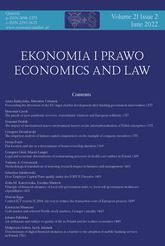How Employee Capital Plans qualify under the IORP II Directive
How Employee Capital Plans qualify under the IORP II Directive
Author(s): Sebastian JakubowskiSubject(s): Labor relations, EU-Legislation, Labour and Social Security Law
Published by: Wydawnictwo Naukowe Uniwersytetu Mikołaja Kopernika
Keywords: employee capital plan; individual pensions; occupational pensions; pension;
Summary/Abstract: Motivation: The pension system in Poland is undergoing another major reform. Between 2019 and 2021 Employee Capital Plans (ECP) are being implemented. This common system of voluntary pension savings schemes is a new element of the third pillar. The purpose of the ECP is to cover the majority of employees and to provide additional pension security for the large part of the labour force in Poland. Since Poland is still implementing the reform, and the system is still quite young, the research background is limited. Aim: This article tries to provide deeper, both legal and economic, analysis of the ECP. On the legal ground, it considers whether ECP provide “cover against biometric risk” or “guarantees a given level of benefits” for the purposes of Article 13(2) of EU Directive 2016/2341 (the “IORP II Directive”). If no such cover and no such guarantee are provided, then an ECP scheme is not required to comply with the technical provisions, buffer, and other funding requirements applicable to an IORP which is classified as a “regulatory own fund” in Article 15 of the IORP II Directive. From the economic perspective, the purpose of the article is to answer the question of how much the ECP members are covered against the risk of longevity. To achieve the research objective the method of critical legal dogmatics and the economic analysis of law method are employed. Results: The article explores how the ECP schemes are classified under the IORP II Directive. It also answers the question of how much the ECP members are covered against the risk of longevity. The main finding of this analysis is that the ECP, as a defined contribution plan, does not protect participants from either biometric risk or asset value declines.
Journal: Ekonomia i Prawo. Economics and Law
- Issue Year: 21/2022
- Issue No: 2
- Page Range: 419-429
- Page Count: 12
- Language: English

